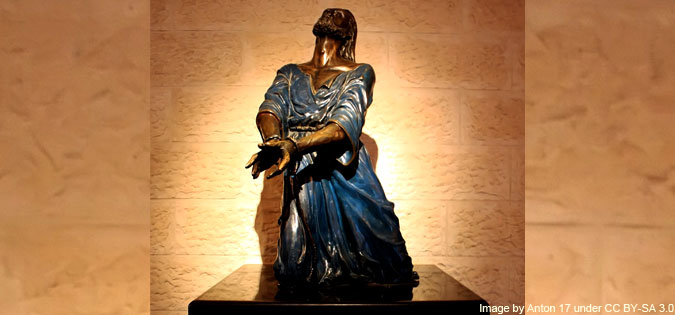
In Jerusalem, a short walk from the Garden of Gethsemane, is the Church of St. Peter in Gallicantu (“at cock crow”). It is built above the remains of an ancient structure that many believe to have been the palace of the High Priest Caiaphas. Archaeologists have uncovered subterranean levels including storehouses, pillars that appear to have been used for scourging, observation posts for guards, and deep, dry cisterns where prisoners were sometimes held for short periods. There is a local tradition that Jesus was kept in one of these cisterns after his late-night appearance before the Sanhedrin, until he was turned over to Pilate in the early morning.
There is a mosaic in the church depicting Jesus being lowered into the cistern by ropes. Modern pilgrims descend a narrow staircase into a small, dimly-lit space. There was just enough room for the eight people in my group to gather in front of the simple altar that had been built along one of the narrow walls. Besides a lace cloth, a crucifix, and two candles, its only adornment was a series of reproductions of Psalm 88, in many languages. The tour leader asked one of the members of the group, a British archaeologist, to read the English version. In the Jerusalem Bible translation, it is a searing cry of desolation by one “numbered among those who go down into the pit . . . a man alone, down among the dead,” who complains to God that, “You have turned my friends and neighbors against me, and darkness is my one companion left.”
Here was a glimpse of Jesus, before the humiliation of the Via Dolorosa and the unspeakable pain of the Cross, taking on the desolation of prisoners everywhere. He shared the feelings of those imprisoned for crimes; those punished for their political opinions; those awaiting trial for offenses they may or may not have committed; those on death row; schoolgirls kidnapped in Nigeria; patients in nursing homes who have lost their independence as well as their health; women and children in abusive relationships who see no way out.
On the Cross, Jesus prayed Psalm 22 (“My God, my God, why have you forsaken me?”). That psalm, after a long lament that is read in the Good Friday liturgy (22:2–19), ends with hope and praise (22:20–32). Jesus had accepted his fate during his agonized prayer in the Garden of Gethsemane (Matthew 26:36-46; Luke 22:41–44). Psalm 88, in contrast, is a cry of despair from one who has had no such experience. Jesus, having accepted his own suffering, now in the darkest hour of the night takes on the suffering of those who have no hope, the darkness of those who see no light, and the loneliness of those who have been abandoned by all.
Traditionally, as we walk with Jesus each Holy Week, we try to imagine his sufferings. As each of us walks our own Via Dolorosa, let us try to remember his compassion. Visit Jesus in the cistern during that long night, and talk to him. Ask him how to share that compassion; how to recognize the people in our lives who are in darkness; how to show them compassion.
Jesus, show me how to bring light out of darkness.
Image by Anton 17 (cropped) under CC BY-SA 3.0.
